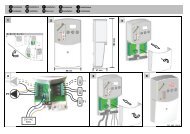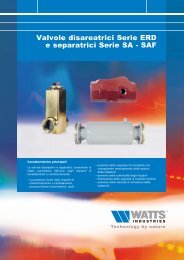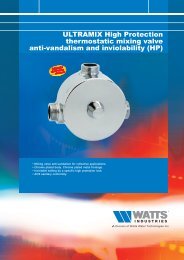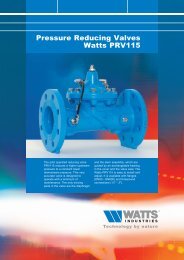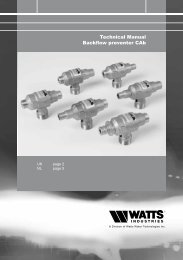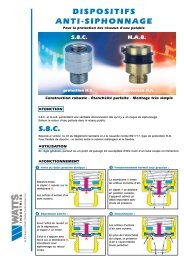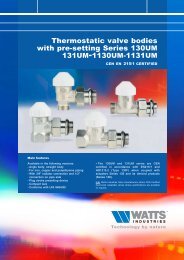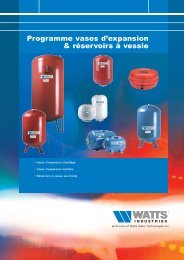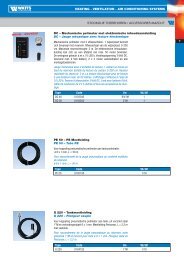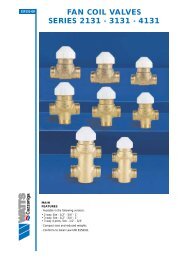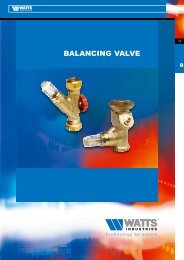Backflow protection devices - Watts Industries
Backflow protection devices - Watts Industries
Backflow protection devices - Watts Industries
- No tags were found...
You also want an ePaper? Increase the reach of your titles
YUMPU automatically turns print PDFs into web optimized ePapers that Google loves.
BACKFLOW PROTECTION DEVICES4IntroductionThe possibility of pollution of drinking water pipelines is a risk not tobe overlooked. In fact, public opinion is very much aware of theproblem, especially after the increased information and concern in theecological field, which has led legislators to gradually adapt theEuropean standards.In this connection considerable resources have been invested intechnological research and manufacture of a range of equipment andaccessories designed to prevent pollution of the water in thedistribution systems.The European Ministry of Health have issued regulations and actsproviding local administrations and private individuals with preventiveand control measures against pollution of drinking water. There aretwo conditions which can give rise to a similar contamination:- contact between non-drinkable water and drinking water- risk of return of pollutants to the drinking water supplyThe EN 1717 is a <strong>protection</strong> method based on a classification of waterinto 5 liquids categories and a classification of pressure levels for theconnections between the drinking water network and one of theseliquids categories. Using these parameters, an installation matrix canbe drawn up. Projecting the installation matrix onto the <strong>protection</strong>matrix, which specifies the maximum level of <strong>protection</strong> for every<strong>protection</strong> device, provides the most adequate security.1. The installation matrixThe installation matrix offers a method for analysing an existingdrinking water installation, or one that must be designed, specifyinginformation regarding the nature of the connection and the possiblecontact. A coloured dot indicates the existence of the parameter.A white dot indicates that the parameter does not exist.2. The <strong>protection</strong> matrixThe <strong>protection</strong> matrix indicates the <strong>protection</strong> options for specific<strong>protection</strong> units, consisting of a <strong>protection</strong> device (e.g. the <strong>Watts</strong> CA9D or the <strong>Watts</strong> BA 009) and the requisite peripheral components,such as ball valves and filters. Obviously, each device has its ownmatrix (see page 6). A coloured dot indicates that security isguaranteed for the parameter for the relevant cell. A white dot meansthat such security is not guaranteed.3. Selecting equipmentIf an installation must be protected against backflow, an installationmatrix should be created for this installation. This enables one toselect the right <strong>Watts</strong> <strong>Industries</strong> equipment with the right securityfeatures for this particular installation. In so doing, you must ensurethat the coloured dot in the installation matrix is covered by a coloureddot in the <strong>protection</strong> matrix.Installation parametersP=atmP>atmHP=atm: Atmospheric pressureNo existing or possible reverse pressure from water column (H)or overpressure (P) directly downstream of the selectedinstallation point for the <strong>protection</strong> device.Back siphonage: when the pressure in the supply main is lowerthan the branch circuit; for example, owing to a break in thepiping or interruption in the drinking water supply.Liquids categoriesIn normal use fluids which are or canbe in contact with potable water areclassified in five categories asdefined below.In cases where insignificantconcentrations or substantialamounts of substances are present itmay be appropriate to redefine thesafety measurement.Category 1:Water to be used for humanconsumption coming directly from apotable water distribution system.Category 2:Fluid presenting no human healthhazard.Fluid recognised as being fit forhuman consumption, including watertaken from a potable waterdistribution system, which can haveundergone a change in taste, odour,colour or a temperature change(heating or cooling).Category 3:Fluid representing some humanhealth hazard due to the presence ofone or more harmful substances 1) .Category 4:Fluid presenting a human healthhazard due to the presence of one ormore toxic or very toxic substances 1)or one or more radioactive,mutagenic or carcinogenicsubstances.Category 5:Fluid presenting a human healthhazard due to the presence ofmicrobiological or viral elements.1)The border between category 3and category 4 is in principleLD 50 > 200 mg/kg body weight inreference to the EU Directive 93/21EEC dated April 27th, 1993.In the following tables on page 5 youwill find a few examples of liquidcategory classifications.P>atm: Existing or possible reverse pressure from water column(H) or overpressure (P) directly downstream of the selectedinstallation point for the <strong>protection</strong> device.<strong>Backflow</strong>: when a non drinkable water circuit, for example aheating system, a pressure is supplied greater than the mainsupply system feeding it.



